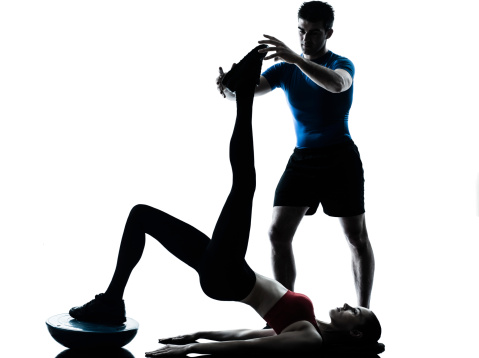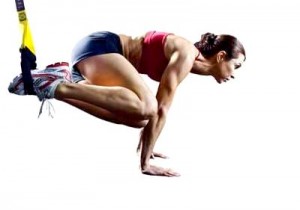Do you want a body that functions better throughout the day? Then why not add in functional training to your regular exercise routine. Functional fitness exercises will help you perform everyday activities better and safer so you’ll be less prone to injury and more efficient in your daily life.

Functional Training
Did you know that women are more prone to muscle strains and injuries than men? Due to hormones and anatomy, women are especially susceptible to knee injuries. Women are also typically busier than men (generally speaking, of course), and we are usually rushing around trying to juggle multiple responsibilities from home and family to work and recreation. We are constantly moving our bodies in many different ways as we pick up a toddler, carry groceries upstairs, bend over to pick up toys, haul luggage on a business trip, move furniture, hit a tennis ball, mop the floor or reach for that can of soup on the top shelf in the pantry.
[spoiler title=”tl;dr – click to read summary” style=”fancy”] Functional fitness for women is a type of exercise program that is specifically designed to help women better perform their daily activities. The routines in this exercise focuses on more than one body part for the body’s muscles to work together. The basic routine makes use of the body weight for resistance and more advance routines make use of fitness equipments such as stability balls, medicine balls, kettle bells, dumbbells, resistance bands, yoga blocks, wobble boards and boxing equipment. [/spoiler]Functional fitness exercises will help you develop your body’s ability to stabilize and generate power from your core to make you stronger. Your core is the key to good balance, stability and posture. Even the most basic activities – from sitting at your desk for hours to bathing and getting dressed – rely on your core. Core stability is the foundation of all basic movements. Did you know that many lower back injuries can be prevented if you have a strong core?
Why Functional Training?
Functional fitness involves training the body for the activities we perform in our daily life. The exercises mimic real life activities and are designed to allow you to perform your day to day activities more easily and without injuries. Each exercise focuses on more than one body part – instead of just one muscle – so all of your muscles work together. This is important because all of our muscles depend on each other and they are supposed to work together. By using your muscles together, you will be more efficient and use less energy in your daily activities – so you’ll have more energy for the things you love to do!
Muscle isolation exercises are also important because they are great for muscle growth but they can sometimes cause disproportion. By adding in some functional fitness exercises, your coordination, balance and stability will improve so your body can function as a whole at its best. Functional exercises are easier on the muscles and joints and they enable you to perform better at the things you have to do – as well as the things you love to do!
Benefits of Functional Training
The main goal of functional training is to get your whole body and all of your muscle groups working together for real life activities. Some of the benefits of functional fitness include:
- Makes your everyday activities easier
- Improves the overall function of your body
- Reduces your risk of injury and falling
- Increases your quality of life
- Lowers your risk of diabetes and other health conditions
- Improves coordination, balance and stability
- Enhances flexibility and range of motion
- Develops strength in your stabilizer muscles
- Builds endurance
- Elevates your metabolism
- Improves your posture by helping to strengthen your back and core
- Helps to prevent obesity
- Helps protect you from some negative aspects of aging, such as loss of balance, flexibility, motor skills and strength
- Helps to diminish arthritis pain, back aches, neck pain and knee problems
Getting Started
 Functional fitness exercises use multiple muscles to enhance your strength, balance, flexibility, speed and coordination. They are also very effective at burning calories because you are using more muscle groups!
Functional fitness exercises use multiple muscles to enhance your strength, balance, flexibility, speed and coordination. They are also very effective at burning calories because you are using more muscle groups!
You can choose to do these exercises at home, at the gym or outside. If you’d like to take a functional training class, you might find one that is offered at a gym. Personal trainers who specialize in functional fitness can provide you with customized exercises and a routine to fit your specific needs. You can also find a variety of functional fitness exercises and routines on DVDs and on the Internet.
Keep in mind that functional fitness exercises are more challenging than traditional weightlifting, so don’t try to go too fast or do too many. Don’t train until your muscles are ready for these exercises – you should stop when you can no longer perform the exercise with perfect form.
Some examples of functional fitness exercises include medicine ball throwing, medicine ball squat with overhead lift, dumbbell lunges and kettle bell swings.
Tools and Equipment
It’s a good idea to start with exercises that use only your own body weight for resistance. Once you are ready for more of a challenge, you can use a variety of different tools and equipment. Some popular options for functional fitness equipment include stability balls, medicine balls, kettle bells, dumbbells, resistance bands, yoga blocks, wobble boards and boxing equipment.



